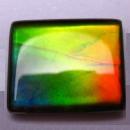|
ClassicGems.net |
|
|
 |
|
Ammolite |
|
|
Discovered in Prehistory; IMA status: Not Valid (a fossil, not a mineral) |
|||
|
|
|
Physical Properties |
|
|
|
|
|
Very Brittle (until fabricated into triplets topped with Quartz or synthetic Spinel) |
|
|
raw material: 2.80; Quartz topped triplet: 7.0; Syn. Spinel topped triplet: 8.0 |
|
|
None |
|
|
Not Radioactive |
|
|
|
|
|
Optical Properties |
|
|
|
|
|
Full spectrum of colors possible; irridescent/opalescent |
|
|
Opaque |
|
|
Vitreous to Resinous |
|
|
|
|
|
Occurances |
|
|
|
|
|
Geological Setting: |
In ironstone concretions, (Siderite or FeCO3) or a thin layer of iron pyrite, (FeS2). |
|
Common Associations: |
Pyrite |
|
Common Impurities: |
None |
|
Type Locality: |
None |
|
Year Discovered: |
Prehistoric |
|
View mineral photos: |
|
|
|
|
|
More Information |
|
|
|
|
|
|
|
|
|
|
|
Ammolite, also known as Korite or Calcentine, is a rare and beautiful opal-like organic gem. Ammolite's name is derived from Ammonite, the name of the squid-like sea creatures that lived about 71 million years ago. It is their fossilized shell that is used to make Ammolite gems. Ammolite is one of the three biogenic gemstones, the other two being Amber and Pearl. Ammolite is fossilized Ammonite shell. Ammonites were squid-like sea creatures that lived about 71 million years ago. Ammonites inhabited a prehistoric, inland subtropical sea that bordered the Rocky Mountains in the western United States and Canada. This sea is known today as the Cretaceous or Western Interior Seaway. As this sea receded, the Ammonites were buried and crushed by layers of bentonite sediment. This sediment preserved the shells consisting of Aragonite, preventing them from converting to Calcite. Most fossilized shells from other locations worldwide have had their Aragonite pseudomorphously replace by Calcite or Pyrite making the existense of Aragonite in Ammonite shells particularly rare. Ammonites became extinct along with dinosaurs at the end of the Mesozoic era. The outer layer of the Ammonite shell consists of Aragonite and is what is used to make Ammolite gems. This layer is usually very thin, up to 1 mm thick, and fragile. Ammolite gems are typically fabricated into triplets with quartz or synthetic spinel top layers and a shale backing. Quartz is a good top with Moh's hardness of 7 but is somewhat brittle. Synthetic Spinel is a better top with Moh's hardness of 8 and it is more durable. Fine examples of Ammolite are prized for their beautiful, irridescent, opal-like play of color. This variety of colors is available mostly in shades of reds and greens although all the spectal colors are possible. The irridescence in Ammolite is due to the microstructure of the Aragonite. The color of most gems comes from light refraction. The irridescent colors of Ammolite comes from interference with the light that rebounds from stacked layers of thin platlets. Thicker layers produce more reds and greens and thinner layers produce more blues and violets. Reds and greens are the more common colors with blues and violets being rarer. Ammolite is available from several sources along the Rocky Mountains. However, significant deposits of gem-quality Ammolite are found in the Bearpaw formation that extends from Alberta to Saskatchewan in Canada and south to Montana in the USA. Possibly the best grade of gem quality Ammolite is found on the eastern slopes of the Rockies in southern Alberta. Most commercial mining of Ammolite is along the banks of the Lehigh River in an area between the cities of Summit Hill and Lethbridge. |
|
|
Ammolite gems for sale: We have not photographed the Ammolite gems yet. Please check back soon. |